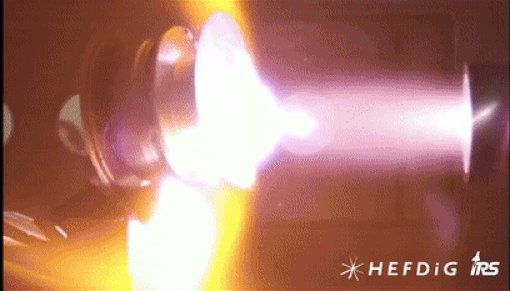A reaction wheel – one of the heaviest parts of a space mission, its changing rotation used to shift a satellite’s orientation – seen in a plasma wind tunnel belonging to the High Enthalpy Flow Diagnostics Group (HEFDiG) at the University of Stuttgart Institute of Space Systems (IRS). Arc-heated gas in the test chamber reaches speeds of several kilometres per second, reproducing reentry conditions, while the reaction wheel itself is being rotated, reproducing the tumbling that takes place as a satellite plunges through the atmosphere.
The reaction wheel itself comes from Collins Aerospace in Germany, which has supported Design for Demise (D4D) activities for many years and introduced several modifications to their TELDIX reaction wheel making it more likely to come apart during satellite reentry in support of demisability.
See the full version of the test clip here.
This clip was presented during this year’s Space Mechanisms Workshop at ESA’s ESTEC technical centre in the Netherlands, focused on current and future requirements and guidelines to reduce the risk from orbital debris, including ESA’s Zero Debris Charter. The event was attended by more than 130 space mechanisms specialists from European industry and academia.
“Space mechanisms cover everything that enable movement aboard a satellite, from deployment devices to reaction wheels,” explains workshop co-organiser Geert Smet. “But these mechanisms often use materials such as steel or titanium that are more likely to survive reentry into the atmosphere. This is a problem because our current regulations say reentering satellites should present a less than one in 10 000 risk of harming people or property on the ground, or even one in 100 000 for large satellite constellations. ESA’s Clean Space group is reacting by D4D – devising methods to make total disintegration of a mission more likely, including mechanisms.”
D4D efforts are focused mainly on platform equipment such as reaction wheels and solar array design mechanisms for the moment, since these are found on almost every satellite, but in the future the approach could be extended to all kinds of satellite mechanisms.
The on-ground risk from reentering objects might seem abstract, but is very real. In 1997 some fortunately lightweight mesh from a Delta II stage hit the shoulder of Lottie Williams in Turley, Oklahoma. The aim in the future is to ensure even the heaviest parts of satellites disintegrate in good time. An alternative approach if this is not practical might be to keep parts of a satellite together to minimise its ground footprint and consequent impact risk.
The workshop also included details on the latest ESA and industry plans to perform active debris removal through dedicated spacecraft to rendezvous with entire derelict satellites and lock onto it for reentry. Mechanisms are crucial to this effort, with capture systems needed to latch onto a target satellite.
Co-organiser Kobyé Bodjona adds: “The idea behind this event is to present the mechanisms community with the latest research on space debris, to see how they might contribute to the work going on. It’s important because large system integrators – the big companies that lead satellite projects – are going to need systems that are fully compliant with debris mitigation regulations. And the need is becoming urgent as more and more satellites are placed in space.”



 Image:
Blowtorch effect of satellite reentry
Image:
Blowtorch effect of satellite reentry